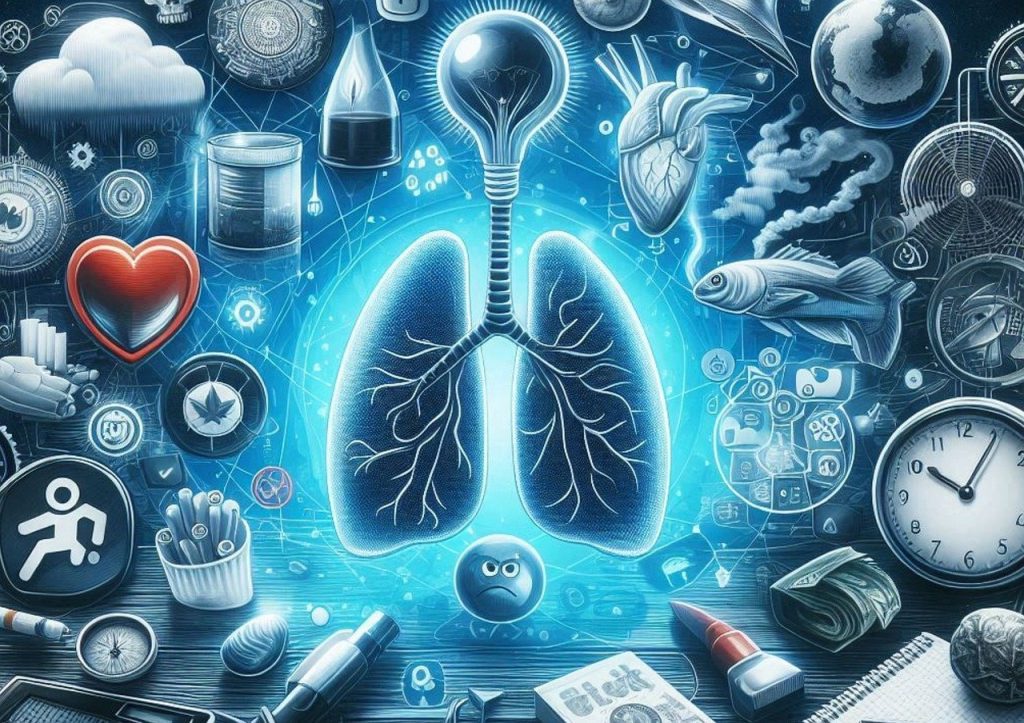With the rise in popularity of e-cigarettes, many people are left wondering: is vaping a safer alternative to smoking? Both smoking and vaping involve inhaling substances into the lungs, but the health risks associated with each are vastly different. In this detailed guide, we will explore 10 key differences between vaping and smoking, from the harmful chemicals found in each to the long-term effects on lung health.
Based on current research, we’ll also dive into the specific risks associated with nicotine, tar, carbon monoxide, and heavy metals in both forms, along with the impact of flavorings in e-liquids. Whether you’re trying to quit smoking or simply curious about the health implications of vaping, this comparison will provide you with the facts you need to make an informed decision.
10. Secondhand Smoke vs. Vaping Aerosol: Risks Compared

When comparing vaping and smoking, one of the first concerns is secondhand exposure. Identifying potential risks to bystanders is crucial, as cigarette smoke contains over 7,000 chemicals, including carcinogens like formaldehyde and benzene. Vaping emits an aerosol—not just harmless vapor—that may contain nicotine, ultrafine particles, and other toxins, posing risks especially to children and those with respiratory conditions.
The ingredients in each product also vary significantly. Traditional cigarettes include tobacco, tar, carbon monoxide, and a host of additives linked to cancer, heart disease, and lung damage. In contrast, vape products use a liquid typically made of nicotine, propylene glycol, vegetable glycerin, and chemical flavorings—some of which have been associated with respiratory harm. Although vaping involves fewer toxic substances, it still carries health concerns.
Smoking is well-documented as a cause of cancer, heart disease, and chronic lung conditions. Vaping, while often seen as a less harmful alternative, can lead to nicotine addiction, lung irritation, and unknown long-term effects. Ultimately, both pose health risks, and understanding these differences is key to making safer choices.
9. The Long-Term Health Consequences of Smoking vs. Vaping

When it comes to long-term health data, smoking has been studied extensively and is conclusively linked to chronic diseases such as lung cancer, emphysema, stroke, and heart disease. These risks are well-documented, and decades of research have shaped public health policies and smoking cessation efforts.
Vaping, by contrast, is still relatively new, and long-term studies are ongoing. Early evidence points to potential risks including respiratory issues, cardiovascular strain, and addiction—particularly among young users. While vaping may reduce exposure to certain harmful chemicals found in cigarettes, it is not without consequences, and the full impact on long-term health remains unknown.
8. Specific Carcinogens: What’s Really Inside?
Understanding the specific chemicals involved is key to evaluating the risks of smoking versus vaping. What are the specific harmful chemicals in cigarettes compared to e-liquids? Traditional cigarettes release over 70 known carcinogens when burned. These include substances like benzene (found in gasoline), formaldehyde (used in embalming fluid), arsenic (a toxic element), and tobacco-specific nitrosamines (TSNAs), which are among the most potent cancer-causing agents. Tar and carbon monoxide also contribute to long-term lung and heart damage.
E-liquids, while generally containing fewer carcinogens, are not free from harmful substances. The aerosol produced by vaping can contain formaldehyde, acetaldehyde, and acrolein—all linked to lung and airway damage. Some flavoring agents, such as diacetyl, have been associated with “popcorn lung,” a serious respiratory condition. Additionally, metals like nickel, tin, and lead have been detected in some e-cigarette aerosols, likely from the heating coils.
While the levels of these chemicals in e-cigarettes may be lower than in tobacco smoke, exposure still poses health risks—especially with frequent or long-term use. Comparing the two helps highlight that “less harmful” does not mean “harmless.”
7. Are There Heavy Metals in Vaping? Risks Compared to Smoking

While much attention is paid to nicotine and flavorings, heavy metals in vape aerosol are an emerging health concern. What heavy metals are found in vape aerosol and not in cigarette smoke? Studies have detected toxic metals such as nickel, chromium, lead, and tin in the aerosol produced by e-cigarettes—often at levels comparable to or exceeding safe exposure limits. These metals typically originate from the device’s heating coil, which can degrade or leach metals into the e-liquid during use.
Traditional cigarette smoke, on the other hand, contains some metals like cadmium and arsenic, primarily from the tobacco leaves and burning process. However, nickel and chromium are not typically present in cigarette smoke at the levels found in some vape products. This makes metal exposure a unique and concerning issue specific to vaping.
Inhalation of heavy metals can have serious health implications. Lead is a neurotoxin, especially harmful to developing brains. Nickel and chromium are classified as carcinogens, and tin can irritate the lungs and respiratory tract. Long-term exposure—even at low doses—can contribute to chronic diseases, organ damage, and increased cancer risk.
These findings underscore the importance of proper device manufacturing standards and highlight that vaping, while different from smoking, introduces its own set of toxic exposures.
6. Flavorings: A Hidden Risk in E-Liquids
In the world of vaping, flavorings are a major selling point. However, some of these additives may pose significant health risks.
Are flavorings in e-liquids a significant health risk compared to cigarette additives?
While cigarette manufacturers often add chemicals like ammonia and sugars to enhance the flavor and smoking experience, the flavorings used in e-liquids are not without their own concerns.
E-liquids can contain a variety of flavoring chemicals, many of which are considered safe for ingestion but not for inhalation. Diacetyl, for example, is a flavoring used to create a buttery taste, but it has been linked to bronchiolitis obliterans (popcorn lung), a serious and irreversible lung condition. Other flavoring chemicals, such as acetyl propionyl and acetoin, have similar concerns due to their ability to irritate the airways and cause long-term damage to the lungs.
In contrast, while cigarettes do contain additives that improve taste or smoking experience, they primarily involve toxic chemicals like formaldehyde, ammonia, and various sugars that contribute to the harmful effects of smoking. Cigarette flavor additives, however, don’t carry the same respiratory risks that some e-liquid flavorings do when vaporized.
Although the long-term effects of inhaling these chemicals from vape products are still being studied, early research suggests that certain flavoring compounds used in vaping could contribute to respiratory issues, inflammation, and lung damage, especially with frequent or prolonged use.
5. How Tobacco Combustion Differs from Vaping and Its Risks

Tobacco, the core ingredient in traditional cigarettes, is responsible for a significant portion of the health risks associated with smoking. Unlike e-cigarettes, which use a liquid that can be modified to contain varying levels of nicotine, traditional cigarettes are made from tobacco leaves, which naturally contain nicotine, along with a multitude of harmful substances.
The burning of tobacco during smoking releases a variety of toxic chemicals, including tar, carbon monoxide, formaldehyde, and benzene. These substances, when inhaled, directly damage the lungs, heart, and other vital organs. Over time, this damage leads to serious conditions like lung cancer, chronic obstructive pulmonary disease (COPD), and heart disease.
Tobacco itself contains natural carcinogens, such as tobacco-specific nitrosamines (TSNAs), which form when the tobacco is cured and processed. These are among the most potent cancer-causing agents found in cigarettes. As the primary source of nicotine in smoking, tobacco also leads to addiction, making quitting difficult for many smokers.
Unlike tobacco, e-cigarettes use nicotine derived from either tobacco or synthetic sources. However, vaping does not involve the combustion of plant matter, which significantly reduces exposure to many of the harmful byproducts of burning tobacco. Still, e-liquids containing nicotine from tobacco carry their own risks, especially when used frequently or in high concentrations.
4. What’s in Vape Juice? Primary E-liquid Ingredients
E-liquids, the substances used in e-cigarettes, are made up of several key ingredients, with the primary base components being Propylene Glycol (PG) and Vegetable Glycerin (VG). These two ingredients act as carriers for nicotine and flavoring compounds, producing the vapor that users inhale. While PG and VG are generally regarded as safe for ingestion, their effects when inhaled are a point of concern.
Propylene Glycol (PG)
Propylene glycol is a synthetic liquid commonly used in food, pharmaceuticals, and cosmetics. It is a key ingredient in many e-liquids due to its ability to produce a throat hit similar to that of traditional smoking. However, when inhaled, PG can cause respiratory irritation in some individuals. Long-term exposure to PG aerosol may lead to symptoms like:
- Dry mouth and throat irritation
- Coughing and wheezing
- Increased risk of asthma or bronchial irritation
- Potential allergic reactions (in rare cases)
Though PG is approved for ingestion and topical use, its safety when inhaled over prolonged periods is not well-established. Some studies have raised concerns about its role in contributing to inflammation and lung damage.
Vegetable Glycerin (VG)
Vegetable glycerin is a thicker, sweeter liquid derived from plant oils, typically used in e-liquids for its ability to produce larger vapor clouds. VG is considered generally safe for consumption and topical application, but its inhalation can also have side effects. When vaporized, VG can break down into acrolein, a harmful compound linked to lung damage and respiratory irritation. Additionally, VG-based vapor can cause:
- Excessive throat irritation
- Increased risk of airway inflammation
- Difficulty breathing (in sensitive individuals)
While VG is less likely to cause irritation than PG, it still carries risks, particularly for those with existing respiratory conditions like asthma. Moreover, the thick nature of VG can leave a residue in the lungs, which may exacerbate breathing problems with repeated exposure.
Overall Risks of PG and VG
While both PG and VG are less harmful than the many toxic chemicals found in cigarette smoke, they are not without risks. The long-term health effects of inhaling these substances are still being studied, and more research is needed to understand their full impact on lung and airway health. It’s important to note that the risk of irritation and respiratory issues may vary from person to person, with some individuals more sensitive to the inhalation of PG or VG.
3. Number of Chemicals: Cigarettes vs. E-Liquids

One of the most significant differences between traditional cigarettes and e-liquids is the sheer number of chemicals involved. Combustible tobacco products like cigarettes contain over 7,000 chemicals, many of which are produced during the burning process. Out of these, at least 70 are known carcinogens. In contrast, most standard e-liquids contain a few dozen identifiable ingredients, depending on the formulation, typically including nicotine, propylene glycol (PG), vegetable glycerin (VG), and various flavoring compounds.
So, what are the specific harmful chemicals in cigarettes compared to e-liquids? In cigarettes, harmful chemicals include:
Formaldehyde – A known carcinogen
Benzene – Found in gasoline, linked to leukemia
Tar – A sticky residue that damages lung tissue
Carbon monoxide – Reduces oxygen delivery in the body
Tobacco-specific nitrosamines (TSNAs) – Strongly linked to cancer
Hydrogen cyanide – Interferes with cellular respiration
Arsenic, cadmium, and lead – Toxic metals that damage organs and tissues
E-liquids, while containing fewer substances, still include harmful compounds, such as:
Nicotine – Highly addictive and harmful to cardiovascular health
Formaldehyde and acetaldehyde – Can form when e-liquids are overheated
Acrolein – Linked to lung irritation and damage
Diacetyl – Associated with bronchiolitis obliterans (“popcorn lung”)
Heavy metals – Including nickel, chromium, and lead from device components
While vaping exposes users to fewer and generally lower levels of toxic chemicals than smoking, it’s a mistake to view e-liquids as completely safe. The reduced number of chemicals doesn’t eliminate risk—especially with long-term, high-frequency use or exposure to poorly regulated products.
2. No Tar or Carbon Monoxide in Vaping: A Key Difference from Smoking

Two of the most damaging substances produced by traditional cigarettes are tar and carbon monoxide—both of which have devastating effects on lung health. Tar is the sticky residue left behind when tobacco is burned. It coats the lungs, paralyzes the cilia (tiny hair-like structures that help clear mucus and toxins), and causes chronic inflammation. Over time, this buildup contributes directly to chronic obstructive pulmonary disease (COPD), emphysema, chronic bronchitis, and lung cancer.
Carbon monoxide is a poisonous gas that forms during combustion and enters the bloodstream when inhaled. It binds to hemoglobin more readily than oxygen, reducing the body’s ability to deliver oxygen to tissues and vital organs. This contributes to fatigue, cardiovascular strain, and worsens lung function in smokers, especially those with pre-existing respiratory conditions.
Vaping, on the other hand, does not produce tar or carbon monoxide because it doesn’t involve combustion. This means vapers generally avoid two of the most harmful substances in cigarette smoke. As a result, vaping is often associated with less lung damage in the short term compared to smoking.
However, this doesn’t make vaping harmless. Vaping can still affect lung health through exposure to irritants like acrolein, formaldehyde, and flavoring chemicals such as diacetyl. These compounds may lead to airway inflammation, asthma-like symptoms, and reduced lung function, especially with long-term use or in individuals with sensitive respiratory systems.
While smoking remains the leading cause of serious lung diseases like COPD and emphysema, vaping has introduced a new set of concerns—particularly in young or non-smoking individuals who take up vaping and may face unknown long-term respiratory risks.
1. Combustion (Smoking) vs. Heating (Vaping): How They Work
At the heart of the difference between smoking and vaping is the method of delivery: combustion versus heating. Smoking involves the burning of tobacco, which creates smoke containing thousands of harmful and carcinogenic chemicals. This combustion process is responsible for producing tar, carbon monoxide, and other toxic byproducts that cause significant damage to the lungs, heart, and blood vessels.
Vaping, in contrast, uses a battery-powered device to heat a liquid (often containing nicotine) into an aerosol. This process avoids combustion and therefore reduces exposure to many of the toxic substances found in cigarette smoke. As a result, vaping generally presents lower levels of harmful chemicals and may be considered less damaging than smoking, particularly for adult smokers trying to quit.
However, heating e-liquids is not without risks. The vapor still contains nicotine, volatile organic compounds, heavy metals, and flavoring agents that can cause respiratory irritation and unknown long-term effects. The safety profile of vaping continues to evolve as more research emerges.
Final Verdict
Smoking is undeniably more harmful due to the toxic load created by combustion, including tar and carbon monoxide, which drive many of the worst health outcomes like cancer, COPD, and heart disease. Vaping, while potentially less harmful, is not safe—especially for youth, non-smokers, or long-term users. The absence of combustion makes vaping a lower-risk alternative for smokers, but not a risk-free option. Choosing to quit both, or never start, remains the healthiest choice.



